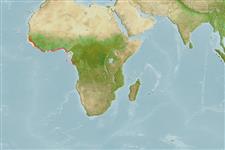Elasmobranquios (tiburones y rayas) (sharks and rays) >
Carcharhiniformes (Ground sharks) >
Sphyrnidae (Hammerhead, bonnethead, or scoophead sharks)
Etymology: Sphyrna: Probable misspelling of sphyra (Gr.), hammer, referring to their hammer-shaped heads (See ETYFish).
Eponymy: Monsieur Couard was Director of shark fisheries off the coast of Senegal, the type locality. Unfortunately we can find nothing more about him. (Ref. 128868), visit book page.
Issue
Junior synonym of Sphyrna lewini (Griffith & Smith 1834) in Ref. 94083,106604. This page will be deleted.
Environment: milieu / climate zone / rango de profundidad / distribution range
Ecología
marino bentopelágico. Tropical; 17°N - 5°S, 19°W - 13°E
Eastern Atlantic: Senegal to Congo. Not in Compagno's 1999 checklist (Ref. 35766).
Tamaño / Peso / Age
Madurez: Lm ? range ? - ? cm
Max length : 300 cm TL macho / no sexado; (Ref. 244)
A coastal-pelagic shark. Feeds on fishes, especially bony fishes, and also benthic and epibenthic cephalopods. Viviparous, with 24 to 28 young in a litter. Size at birth about 30 to 32 cm.
Life cycle and mating behavior
Madurez | Reproducción | Puesta | Huevos | Fecundidad | Larva
Viviparous, placental (Ref. 50449).
Compagno, L.J.V., 1984. FAO Species Catalogue. Vol. 4. Sharks of the world. An annotated and illustrated catalogue of shark species known to date. Part 2 - Carcharhiniformes. FAO Fish. Synop. 125(4/2):251-655. Rome: FAO. (Ref. 244)
IUCN Red List Status (Ref. 130435: Version 2025-1)
Threat to humans
Traumatogenic
Human uses
Pesquerías: pesquerías de subsistencia
Herramientas
Special reports
Download XML
Fuentes de Internet
Estimates based on models
Preferred temperature (Referencia
123201): 24.4 - 28, mean 26.7 °C (based on 64 cells).
Phylogenetic diversity index (Referencia
82804): PD
50 = 0.5006 [Uniqueness, from 0.5 = low to 2.0 = high].
Bayesian length-weight: a=0.00347 (0.00153 - 0.00788), b=3.12 (2.93 - 3.31), in cm total length, based on LWR estimates for this (Sub)family-body shape (Ref.
93245).
Nivel trófico (Referencia
69278): 4.5 ±0.54 se; based on food items.
Resiliencia (Referencia
120179): Bajo, población duplicada en un tiempo mínimo de 4.5-14 años (Fec=24).
Fishing Vulnerability (Ref.
59153): Very high vulnerability (90 of 100).
🛈
